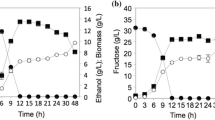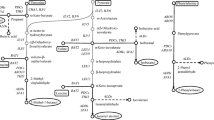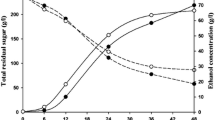Abstract
Zygosaccharomyces rouxii referred as Yeast S is an important microorganism widely applied in traditional fermented food to accelerate flavor formation. Z. rouxii 3-2 referred as Yeast S 3-2 constructed previously is a new strain having higher salt tolerance than wild type. In this study, salt stress response of synthesis key flavor metabolites 3-methylthiopropanol, 2-phenylethyl alcohol, and isoamyl acetate in Yeast S and S 3-2 were investigated based on SPME–GC–MS and RT-qPCR. Analysis of GC–MS data showed that high salinity led to increase the contents of 3-methylthiopropanol and 2-phenylethyl alcohol both in Yeast S and Yeast S 3-2, while inhibited the synthesis of isoamyl acetate, and the induced effect on Yeast S 3-2 was more pronounced than Yeast S. Furthermore, the RT-qPCR results revealed that the salinity could enhance the genes expression of ARO10 and PDC1, and stronger effect on Yeast S 3-2 than S. However, the gene expression of AFT1 was reduced in high-salt culture conditions, which was consistent with the results of GC–MS data. The results presented in this study can provide theoretical support of Z. rouxii 3-2 application during food fermentation.

Similar content being viewed by others
References
Wei Q, Wang H, Chen Z, Lv Z, Xie Y, Lu F (2013) Profiling of dynamic changes in the microbial community during the soy sauce fermentation process. Appl Microbiol Biotechnol 97:9111–9119
Dakal TC, Solieri L, Giudici P (2014) Adaptive response and tolerance to sugar and salt stress in the food yeast Zygosaccharomyces rouxii. Int J Food Microbiol 185:140–157
Lee KE, Lee SM, Choi YH, Hurh BS, Kim YS (2013) Comparative volatile profiles in soy sauce according to inoculated microorganisms. Biosci Biotechnol Biochem 77:2192–2200
Cao X, Hou L, Lu M, Wang C, Zeng B (2010) Genome shuffling of Zygosaccharomyces rouxii to accelerate and enhance the flavour formation of soy sauce. J Sci Food Agric 90:281–285
Hauck T, Bruhlmann F, Schwab W (2003) 4-Hydroxy-2,5-dimethyl-3(2H)-furanone formation by Zygosaccharomyces rouxii: effect of the medium. J Agric Food Chem 51:4753–4756
Vuralhan Z, Luttik MA, Tai SL, Boer VM, Morais MA, Schipper D, Almering MJ, Kotter P, Dickinson JR, Daran JM, Pronk JT (2005) Physiological characterization of the ARO10-dependent, broad-substrate-specificity 2-oxo acid decarboxylase activity of Saccharomyces cerevisiae. Appl Environ Microbiol 71:3276–3284
Lilly M, Bauer FF, Styger G, Lambrechts MG, Pretorius IS (2010) The effect of increased branched-chain amino acid transaminase activity in yeast on the production of higher alcohols and on the flavour profiles of wine and distillates. FEMS Yeast Res 6:726–743
Hazelwood L, Daran J, van Maris A, Pronk J, Dickinson J (2008) The ehrlich pathway for fusel alcohol production: a century of research on Saccharomyces cerevisiae metabolism. Appl Environ Microbiol 74:2259–2266
Sluis C, Rahardjo Y, Smit B, Kroon P, Hartmans S, Schure E, Tramper J, Wijffels R (2002) Concomitant extracellular accumulation of alpha-keto acids and higher alcohols by Zygosaccharomyces rouxii. J Biosci Bioeng 93:117–124
Akoh CC, Lee GC, Shaw JF (2004) Protein engineering and applications of Candida rugosa lipase isoforms. Lipids 39:513–526
Verstrepen KJ, Van Laere SD, Vanderhaegen BM, Derdelinckx G, Dufour JP, Pretorius IS, Winderickx J, Thevelein JM, Delvaux FR (2003) Expression levels of the yeast alcohol acetyltransferase genes ATF1, Lg-ATF1, and ATF2 control the formation of a broad range of volatile esters. Appl Environ Microbiol 69:5228–5237
Saerens SM, Verstrepen KJ, Van Laere SD, Voet AR, Van Dijck P, Delvaux FR (2006) The Saccharomyces cerevisiae EHT1 and EEB1 genes encode novel enzymes with medium-chain fatty acid ethyl ester synthesis and hydrolysis capacity. J Biol Chem 281:4446–4456
Gao XL, Cui C, Zhao HF, Zhao MM, Yang L, Ren JY (2010) Changes in volatile aroma compounds of traditional Chinese-type soy sauce during moromi fermentation and heat treatment. Food Sci Biotechnol 19:889–898
Zhang LQ, Zhou RQ, Cui RY, Huang J, Wu CD (2016) Characterizing soy sauce moromi manufactured by high-salt dilute-state and low-salt solid-state fermentation using multiphase analyzing methods. J Food Sci 81:C2639–C2646
Scognamiglio J, Jones L, Letizia CS, Api AM (2012) Fragrance material review on phenylethyl alcohol. Food Chem Toxicol 50:S224–S239
Devanthi PVP, Linforth R, Onyeaka H, Gkatzionis K (2018) Effects of co-inoculation and sequential inoculation of Tetragenococcus halophilus and Zygosaccharomyces rouxii on soy sauce fermentation. Food Chem 240:1–8
Kobayashi M, Hayashi S (1998) Supplementation of NaCl to starter culture of the soy yeast Zygosaccharomyces rouxii. J Ferment Bioeng 85:642–644
Van der Sluis C, Wolken WAM, Giuseppin MLF, Tramper J, Wijffels RH (2000) Effect of threonine, cystathionine, and the branched-chain amino acids on the metabolism of Zygosaccharomyces rouxii*. Enzyme Microb Technol 26:292–300
Watanabe Y, Takakuwa M (1987) Change of lipid composition of Zygosaccharomyces rouxii after transfer to high sodium chloride culture medium. J Ferment Technol 65:365–369
Hou L, Wang M, Wang C, Wang C, Wang H (2013) Analysis of salt-tolerance genes in Zygosaccharomyces rouxii. Appl Biochem Biotechnol 170:1417–1425
Wang D, Hao Z, Zhao J, Jin Y, Huang J, Zhou R, Wu C (2019) Comparative physiological and transcriptomic analyses reveal salt tolerance mechanisms of Zygosaccharomyces rouxii. Process Biochem 82:59–67
Chen SA, Xu Y (2010) The influence of yeast strains on the volatile flavour compounds of Chinese rice wine. J Inst Brew 116:190–196
Qi W, Fan ZC, Wang CL, Hou LH, Liu JF, Cao XH (2014) Non-targeted metabolomic reveals the effect of salt stress on global metabolite of halotolerant yeast Candida versatilis and principal component analysis. J Ind Microbiol Biotechnol 41:1553–1562
Peng B, Li F, Cui L, Guo Y (2015) Effects of fermentation temperature on key aroma compounds and sensory properties of apple wine. J Food Sci 80:S2937–S2943
Liu J, Wu Q, Wang P, Lin J, Huang L, Xu Y (2017) Synergistic effect in core microbiota associated with sulfur metabolism in spontaneous Chinese liquor fermentation. Appl Environ Microbiol 83:e01475-17
Park HJ, Lee SM, Song SH, Kim YS (2013) Characterization of volatile components in Makgeolli, a traditional korean rice wine, with or without pasteurization, during storage. Molecules 18:5317–5325
Fedrizzi B, Zapparoli G, Finato F, Tosi E, Turri A, Azzolini M, Versini G (2011) Model aging and oxidation effects on varietal, fermentative, and sulfur compounds in a dry botrytized red wine. J Agric Food Chem 59:1804–1813
Gao X, Zhang J, Regenstein JM, Yin Y, Zhou C (2018) Characterization of taste and aroma compounds in Tianyou, a traditional fermented wheat flour condiment. Food Res Int 106:156–163
Perpete P, Duthoit O, De Maeyer S, Imray L, Lawton AI, Stavropoulos KE, Gitonga VW, Hewlins MJ, Dickinson JR (2006) Methionine catabolism in Saccharomyces cerevisiae. FEMS Yeast Res 6:48–56
Yoshikawa S, Kurihara H, Kawai Y, Yamazaki K, Tanaka A, Nishikiori T, Ohta T (2010) Effect of halotolerant starter microorganisms on chemical characteristics of fermented chum salmon (Oncorhynchus keta) sauce. J Agric Food Chem 58:6410–6417
Chreptowicz K, Wielechowska M, Główczyk-Zubek J, Rybak E, Mierzejewska J (2016) Production of natural 2-phenylethanol: from biotransformation to purified product. Food Bioprod Process 100:275–281
Martínez-Avila O, Sánchez A, Font X, Barrena R (2018) Bioprocesses for 2-phenylethanol and 2-phenylethyl acetate production: current state and perspectives. Appl Microbiol Biotechnol 102:9991–10004
Romagnoli G, Luttik MA, Kotter P, Pronk JT, Daran JM (2012) Substrate specificity of thiamine pyrophosphate-dependent 2-oxo-acid decarboxylases in Saccharomyces cerevisiae. Appl Environ Microbiol 78:7538–7548
Vuralhan Z, Morais MA, Tai SL, Piper MD, Pronk JT (2003) Identification and characterization of phenylpyruvate decarboxylase genes in Saccharomyces cerevisiae. Appl Environ Microbiol 69:4534–4541
Ugliano M, Moio L (2005) Changes in the concentration of yeast-derived volatile compounds of red wine during malolactic fermentation with four commercial starter cultures of Oenococcus oeni. J Agric Food Chem 53:10134–10139
Cullere L, Escudero A, Cacho J, Ferreira V (2004) Gas chromatography-olfactometry and chemical quantitative study of the aroma of six premium quality Spanish aged red wines. J Agric Food Chem 52:1653–1660
Ekberg J, Rautio J, Mattinen L, Vidgren V, Londesborough J, Gibson BR (2013) Adaptive evolution of the lager brewing yeast Saccharomyces pastorianus for improved growth under hyperosmotic conditions and its influence on fermentation performance. FEMS Yeast Res 13:335–349
Cha YJ, Wang W, Cha HR (2016) Studies on volatile flavor compounds of soy sauce residue. J Korean Soc Food Sci Nutr 45:1755–1761
Krishna S, Hari Divakar S, Prapulla SG, Karanth NG (2001) Enzymatic synthesis of isoamyl acetate using immobilized lipase from Rhizomucor miehei. J Biotechnol 87:193–201
Qi W, Guo HL, Wang CL, Hou LH, Cao XH, Liu JF, Lu FP (2017) Comparative study on fermentation performance in the genome shuffled Candida versatilis and wild-type salt tolerant yeast strain. J Sci Food Agric 97:284–290
Fujiwara D, Kobayashi O, Yoshimoto H, Harashima S, Tamai Y (1999) Molecular mechanism of the multiple regulation of the Saccharomyces cerevisiae ATF1 gene encoding alcohol acetyltransferase. Yeast 15:1183–1197
Acknowledgements
This study was supported by National Key Research and Development Plan (2018YFC1604102); Engineering Research Center of Food Biotechnology, Ministry of Education, Tianjin University of Science and Technology (grant number SPZX007-18); Tianjin Science and Technology Project (17YDLJNC00130, 17PTSYJC00080, 18ZYPTJC00020); National “Thirteenth Five Year” Plan for Science and Technology Support (2016YFD0400505).
Author information
Authors and Affiliations
Corresponding author
Ethics declarations
Conflict of interest
There are no conflicts to declare.
Additional information
Publisher's Note
Springer Nature remains neutral with regard to jurisdictional claims in published maps and institutional affiliations.
Electronic supplementary material
Below is the link to the electronic supplementary material.
Supplementary Figure 1
The gene expression level of gene ARO10, PDC1 and ATF1. The expression levels were showed by bands separated from agarose gel electrophoresis at different sampling times. Sampling was carried out every six hours between 6-60 h (a-i). And the bands were divided into three groups according to different salinity at 0% (†1, †2), 9% (†3, †4) and 18% (†5, †6). †1, †3 and †5 represent the genes in Yeast S, †2, †4 and †6 represent the genes in Yeast S3-2, and, * represent 18S RNA in both two strains. (DOC 290 kb)
Rights and permissions
About this article
Cite this article
Liu, B., Wang, X., Zhao, J. et al. Effects of salinity on the synthesis of 3-methylthiopropanol, 2-phenylethanol, and isoamyl acetate in Zygosaccharomyces rouxii and Z. rouxii 3-2. Bioprocess Biosyst Eng 43, 831–838 (2020). https://doi.org/10.1007/s00449-019-02279-3
Received:
Accepted:
Published:
Issue Date:
DOI: https://doi.org/10.1007/s00449-019-02279-3




